Binaural beats can reduce your stress by influencing your brainwaves through a process called entrainment. When you listen to two slightly different frequencies in each ear, your brain perceives a third tone that can guide it into specific mental states. This auditory illusion can help calm racing thoughts, promote relaxation, and improve focus. Different frequency ranges correspond to various states of consciousness, from deep sleep to heightened creativity. By selecting the right frequency, you can effectively manage anxiety, enhance sleep quality, and gain better mental control. Understanding the science behind this sound therapy opens up a world of stress-reduction possibilities.
Understanding Binaural Beats
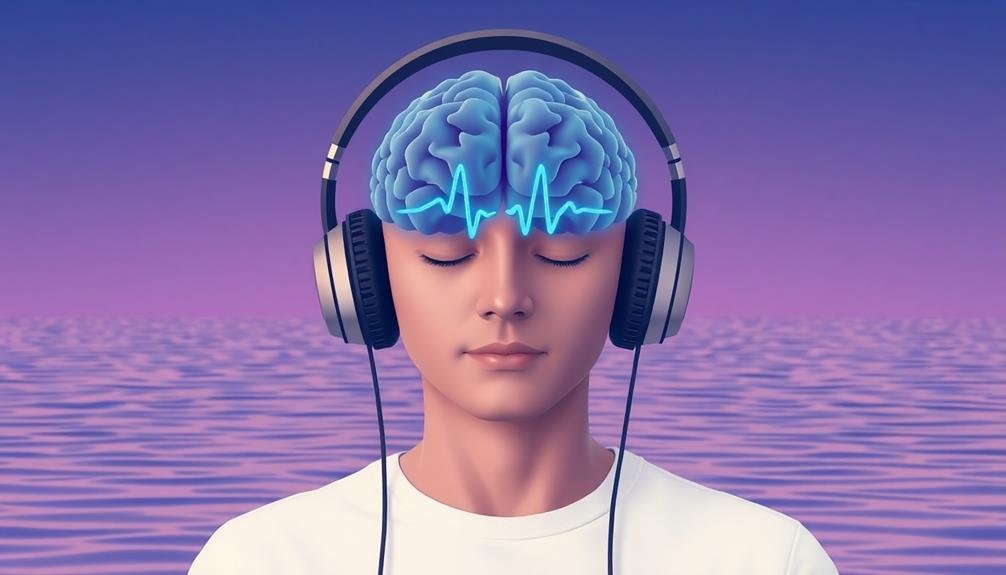
Curiosity often leads us to explore new methods for stress reduction, and binaural beats have gained attention in recent years.
But what exactly are binaural beats? They're an auditory illusion created when you listen to two slightly different frequencies in each ear. Your brain perceives a third tone, which is the difference between the two frequencies.
For example, if you hear a 440 Hz tone in your left ear and a 444 Hz tone in your right ear, your brain will process a 4 Hz binaural beat. This perceived tone isn't actually present in the audio you're listening to; it's generated by your brain's interpretation of the two separate frequencies.
Binaural beats work by influencing your brainwave activity. Different frequency ranges correspond to various mental states, from deep relaxation to heightened focus.
By listening to specific binaural beat frequencies, you can potentially guide your brain into a desired state of consciousness. This process is called brainwave entrainment, where your brain's electrical activity synchronizes with an external stimulus.
It's this synchronization that's believed to contribute to stress reduction and other potential benefits.
The Science Behind Sound Therapy
You'll find that sound therapy relies on the principle of brainwave entrainment, where your brain synchronizes with external stimuli.
This process, known as the Frequency Following Response, occurs when your brain matches the frequency of auditory or visual cues.
Brainwave Entrainment Explained
Brainwave entrainment is the cornerstone of sound therapy, including binaural beats.
It's the process by which your brain synchronizes its electrical activity with external stimuli, such as sound or light. When you listen to binaural beats, your brain responds by producing brainwaves that match the frequency difference between the tones played in each ear.
This synchronization can lead to various mental states, depending on the frequency used:
- Delta waves (0.5-4 Hz): Deep sleep and healing
- Theta waves (4-8 Hz): Relaxation, meditation, and creativity
- Alpha waves (8-13 Hz): Calm alertness and stress reduction
- Beta waves (13-30 Hz): Focused attention and problem-solving
Frequency Following Response
How exactly does your brain respond to binaural beats? The key lies in a phenomenon called the Frequency Following Response (FFR). When you're exposed to binaural beats, your brain doesn't just passively receive the sound; it actively synchronizes its electrical activity to match the perceived frequency.
This synchronization occurs in your auditory cortex, where your brain processes sound. As you listen to binaural beats, neurons in this region begin to fire at the same rate as the perceived beat frequency. This neural entrainment then spreads to other areas of your brain, influencing your overall brainwave patterns.
The FFR isn't limited to binaural beats; it can occur with any rhythmic auditory stimulus. However, binaural beats are particularly effective because they create a clear, consistent beat frequency that your brain can easily latch onto.
As your brainwaves align with the beat frequency, you may experience changes in your mental state, such as increased relaxation or improved focus, depending on the specific frequency used. This neurological response forms the foundation of binaural beats' potential for stress reduction and other cognitive benefits.
How Binaural Beats Affect Brainwaves
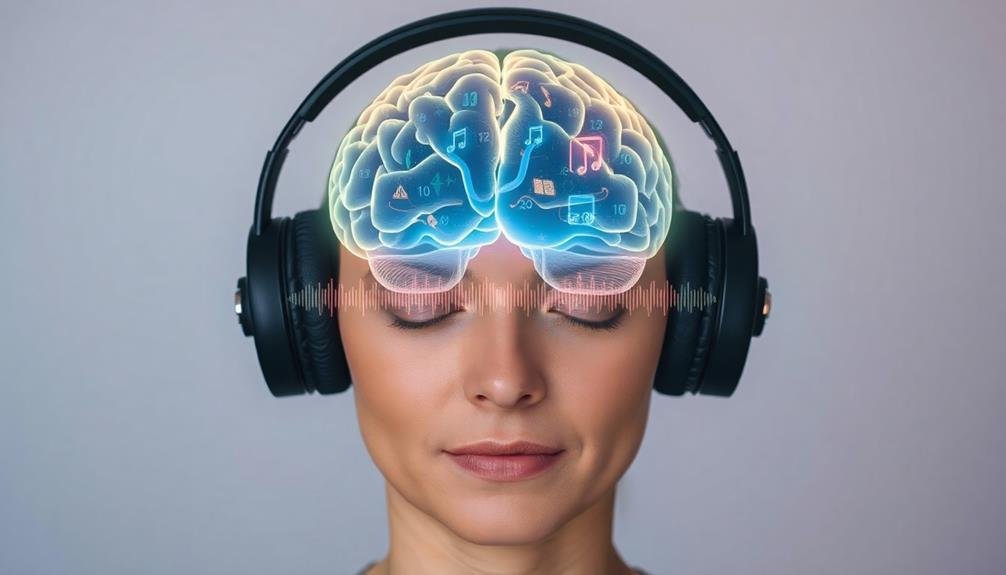
Understanding the impact of binaural beats on brainwaves requires a brief exploration of how our brain processes sound. When you listen to binaural beats, your brain receives two slightly different frequencies in each ear.
It then creates a third, phantom frequency equal to the difference between the two. This process, known as the frequency following response, causes your brainwaves to synchronize with the phantom beat.
Binaural beats can influence your brainwave patterns in several ways:
- Delta waves (0.5-4 Hz): Promote deep sleep and relaxation
- Theta waves (4-8 Hz): Enhance creativity and meditation
- Alpha waves (8-13 Hz): Increase relaxation and reduce anxiety
- Beta waves (13-30 Hz): Improve focus and alertness
Benefits for Anxiety Management
When you're struggling with anxiety, binaural beats can help calm your racing thoughts.
You'll find these specialized audio tracks promote a relaxation response in your body and mind.
Calming Racing Thoughts
For those struggling with anxiety, racing thoughts can be particularly debilitating. Binaural beats offer a powerful tool to calm your mind and slow down the constant barrage of worries. By listening to these specialized audio tracks, you're engaging your brain in a way that can help quiet the mental chatter.
When you use binaural beats to address racing thoughts, you'll likely experience:
- Reduced mental clutter
- Improved focus and concentration
- A sense of mental spaciousness
- Easier changes into relaxation or sleep
The rhythmic, consistent nature of binaural beats helps anchor your attention, giving your mind something steady to latch onto. This can interrupt the cycle of rumination and allow you to step back from your thoughts.
You'll find it easier to observe your worries without getting caught up in them. As you continue to use binaural beats, you may notice that your ability to manage racing thoughts improves even when you're not actively listening.
This is because you're training your brain to enter more calm, focused states. With regular practice, you'll develop greater control over your thought patterns and find relief from the constant mental noise that often accompanies anxiety.
Promoting Relaxation Response
The relaxation response is a powerful antidote to anxiety, and binaural beats can help you tap into it more easily. When you listen to binaural beats, your brain begins to synchronize with the frequencies, inducing a state of deep relaxation. This process, known as entrainment, can effectively counteract the body's stress response.
As you immerse yourself in binaural beats, you'll notice your muscles starting to relax and your breathing becoming slower and deeper. This physical relaxation is accompanied by mental calmness, as the beats help quiet your mind and reduce anxious thoughts. You'll find it easier to let go of worries and focus on the present moment.
Regular use of binaural beats can train your brain to enter this relaxed state more readily, even when you're not listening. This makes it an excellent tool for managing chronic anxiety. You'll develop better stress resilience and find it easier to maintain calm in challenging situations.
Additionally, the relaxation response triggered by binaural beats can improve your sleep quality, boost your immune system, and enhance your overall well-being, creating a positive cycle that further reduces anxiety levels.
Choosing the Right Frequency
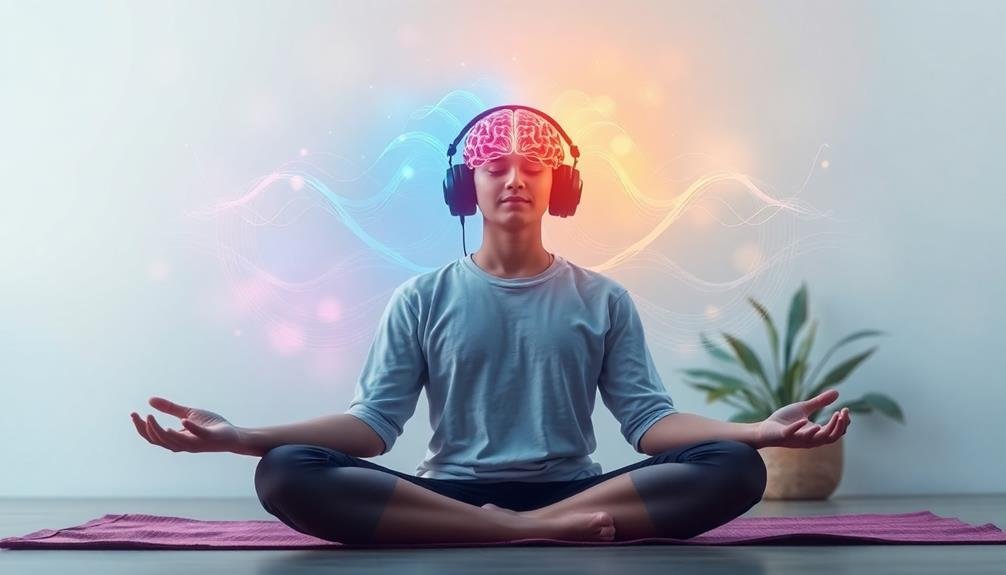
Selecting the appropriate frequency is essential for maximizing the stress-reducing benefits of binaural beats. You'll want to choose a frequency that aligns with your specific relaxation goals. Lower frequencies, typically between 4-8 Hz, are associated with deep relaxation and meditation, while slightly higher frequencies around 8-14 Hz can promote a calm, focused state.
When choosing the right frequency, consider these factors:
- Your current stress level
- The time of day you're listening
- Your intended activity during or after listening
- Your personal response to different frequencies
It's important to experiment with various frequencies to find what works best for you. You might start with a frequency around 6 Hz for deep relaxation, or 10 Hz for a more alert but calm state.
Pay attention to how your body and mind respond to different frequencies. Some people find that alternating between frequencies during a session enhances their relaxation experience.
Listening Techniques for Maximum Effect
To maximize the stress-reducing effects of binaural beats, proper listening techniques are essential. First, find a quiet, comfortable space where you won't be disturbed. Lie down or sit in a relaxed position, closing your eyes to minimize external distractions. Use high-quality headphones to guarantee each ear receives the correct frequency and to block out ambient noise.
Begin your session with a few deep breaths to center yourself. As you listen, try to clear your mind of thoughts and focus solely on the sounds. If your mind wanders, gently bring your attention back to the beats.
Start with shorter sessions of 15-20 minutes and gradually increase to 30-60 minutes as you become more comfortable with the practice. Consistency is key, so aim to listen daily or at least several times a week.
You can incorporate binaural beats into your existing meditation or relaxation routine for enhanced effects. Some people find it helpful to set an intention before each session, such as reducing anxiety or improving focus.
Incorporating Binaural Beats Into Routines

Seamless integration of binaural beats into your daily routine can amplify their stress-reducing benefits. Start by identifying key moments in your day when you're most susceptible to stress or need a boost in focus. These might include your morning commute, lunch break, or evening wind-down time.
Once you've pinpointed these opportunities, create a playlist or select specific tracks that align with your goals for each period.
To effectively incorporate binaural beats into your routine:
- Set reminders: Use your phone or smartwatch to prompt you when it's time to listen.
- Pair with existing habits: Combine binaural beats with activities you already do, like meditation or reading.
- Experiment with timing: Try different durations to find what works best for you, from quick 5-minute sessions to longer 30-minute periods.
- Adjust as needed: Be flexible and modify your routine based on your changing needs and schedule.
Combining With Other Relaxation Methods
Numerous relaxation techniques can complement binaural beats, enhancing their stress-reducing effects. You can combine binaural beats with deep breathing exercises, focusing on slow, deliberate breaths while listening to the audio. This pairing can help you achieve a deeper state of relaxation and mindfulness.
Progressive muscle relaxation is another effective method to use alongside binaural beats. As you listen, systematically tense and release different muscle groups, promoting physical and mental relaxation.
Guided imagery pairs well with binaural beats, allowing you to visualize calming scenes while the audio promotes a relaxed state. You can also incorporate gentle stretching or yoga poses while listening, combining the benefits of physical movement with auditory relaxation.
Journaling during or after a binaural beats session can help you process thoughts and emotions, further reducing stress. For a holistic approach, try using aromatherapy or essential oils in conjunction with binaural beats. The combination of soothing scents and sounds can create a multi-sensory relaxation experience.
Potential Side Effects and Precautions
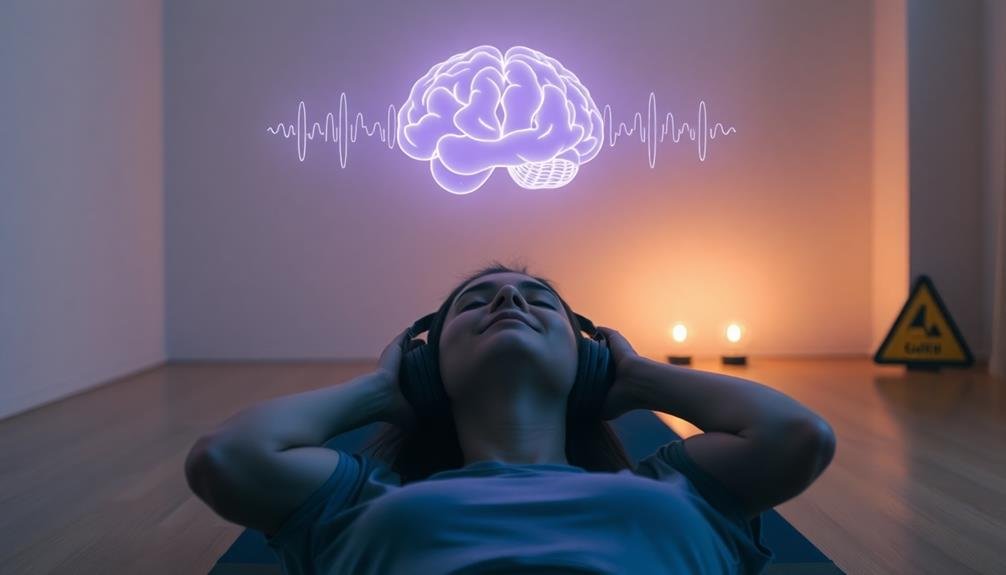
While generally safe for most users, binaural beats may cause side effects in some individuals. Be aware of potential issues like headaches, dizziness, or changes in mood. If you experience any discomfort, stop using binaural beats immediately and consult a healthcare professional.
It's essential to exercise caution when using binaural beats, especially if you have certain medical conditions. Consider these precautions:
- Epilepsy: If you have epilepsy or are prone to seizures, avoid binaural beats as they may trigger episodes.
- Pregnancy: Pregnant women should consult their doctor before using binaural beats, as their effects on fetal development aren't fully understood.
- Heart conditions: Those with heart problems should use caution, as binaural beats can affect heart rate and blood pressure.
- Mental health disorders: If you have a mental health condition, consult your therapist before incorporating binaural beats into your routine.
Always use binaural beats at a comfortable volume to protect your hearing. Don't use them while driving or operating machinery, as they can cause drowsiness.
Start with short sessions and gradually increase duration to gauge your body's response. Remember, binaural beats aren't a substitute for professional medical advice or treatment.
Research and Clinical Studies
Despite the potential side effects and precautions, scientific research has shown promising results for binaural beats in stress reduction. You'll find numerous studies supporting their effectiveness in managing stress and anxiety.
A 2019 study published in the journal "Frontiers in Human Neuroscience" found that binaural beats in the theta frequency range considerably reduced anxiety levels in participants.
Another study from 2017 in the "Journal of Alternative and Complementary Medicine" reported that binaural beats improved mood and reduced stress in patients undergoing general anesthesia.
You'll also discover research indicating binaural beats' positive effects on cognitive performance and sleep quality. A 2018 study in "Psychological Research" showed that alpha frequency binaural beats enhanced creativity and problem-solving abilities.
While these findings are encouraging, it's essential to point out that more research is needed to fully understand the long-term effects and ideal usage of binaural beats.
Some studies have produced mixed results, and the effectiveness may vary among individuals. As you explore this stress-reduction technique, consider consulting with a healthcare professional to determine if it's suitable for your specific needs.
Creating Your Own Binaural Beats

Creating your own binaural beats can be a rewarding and cost-effective way to tailor your stress reduction experience. With a few basic tools and some knowledge of audio production, you can craft custom binaural beats that suit your specific needs and preferences.
To get started, you'll need audio editing software like Audacity, which is free and user-friendly. Begin by generating two pure tones with a slight frequency difference between them. For example, you might create a 200 Hz tone for the left ear and a 210 Hz tone for the right ear, resulting in a 10 Hz binaural beat.
Here's a step-by-step guide to creating your own binaural beats:
- Choose your desired frequency range (e.g., alpha waves for relaxation).
- Generate two separate tones with a frequency difference matching your target.
- Pan one tone to the left channel and the other to the right.
- Export the audio file in a format compatible with your listening device.
Experiment with different frequencies and durations to find what works best for you. Remember to use headphones when listening to guarantee proper separation of the tones between your ears.
Alternative Sound Therapies for Stress
While binaural beats can be effective, you might also consider other sound therapies for stress reduction.
Nature sounds, such as rainforest ambiance or ocean waves, can transport you to a peaceful environment and promote relaxation.
ASMR (Autonomous Sensory Meridian Response) techniques, including whispered voices and gentle tapping sounds, offer another unique approach to calming your mind and easing tension.
Nature Sounds for Relaxation
How can the sounds of nature help you unwind and reduce stress? Nature sounds have a unique ability to calm your mind and body, transporting you to serene environments even when you're stuck indoors. These soothing sounds can lower your heart rate, reduce cortisol levels, and promote a sense of peace and tranquility.
When you're feeling overwhelmed, try incorporating these natural sounds into your relaxation routine:
- Gentle ocean waves
- Soft rainfall on leaves
- Rustling forest winds
- Babbling brooks or streams
These sounds work by masking disruptive noises and engaging your senses in a non-intrusive way. They create a peaceful backdrop that allows your mind to drift and your body to relax.
You'll find that nature sounds can improve your focus, enhance sleep quality, and even boost your mood.
To get started, you can use smartphone apps, dedicated sound machines, or online playlists. Experiment with different nature sounds to find what resonates with you most. You might prefer a mix of sounds or a single, continuous audio stream.
ASMR Stress Relief Techniques
ASMR, or Autonomous Sensory Meridian Response, has gained popularity as a unique stress relief technique. This sensory phenomenon triggers a tingling sensation that typically begins on the scalp and moves down the spine, often accompanied by feelings of relaxation and well-being.
You'll find a wide variety of ASMR content online, including whispered voices, gentle tapping, and soft brushing sounds.
To experience ASMR's stress-relieving benefits, start by finding triggers that work for you. You might prefer visual stimuli, like watching someone fold clothes or draw, or auditory triggers such as whispering or page-turning.
Experiment with different videos or audio recordings to discover what elicits the strongest response.
When using ASMR for stress relief, create a quiet, comfortable environment free from distractions. Use headphones for the best experience, as they'll help you pick up on subtle sounds and create a more immersive experience.
Regular ASMR sessions can help lower your heart rate, reduce anxiety, and improve sleep quality. While not everyone experiences the trademark tingles, many still find ASMR content calming and conducive to relaxation.
Frequently Asked Questions
Can Binaural Beats Be Harmful if Listened to Too Frequently?
You shouldn't worry too much about harmful effects from frequent binaural beat listening. However, it's wise to use them in moderation. Overuse might lead to headaches or discomfort. Always listen at a comfortable volume and take breaks.
Do Binaural Beats Work for Everyone, or Are Some People Immune?
Binaural beats don't work for everyone. You might find them effective, but some people are less responsive. It's not about immunity; rather, individual brain chemistry and perception vary. Try them to see if they work for you.
How Long Does It Take to Feel the Effects of Binaural Beats?
You'll typically feel the effects of binaural beats within 10-30 minutes of listening. However, it's different for everyone. Some people experience benefits quickly, while others might need longer exposure or repeated sessions for noticeable results.
Are There Any Age Restrictions for Using Binaural Beats?
There aren't official age restrictions for binaural beats, but you should use caution with children. If you're under 18, it's best to consult a parent or doctor before trying them. Adults can generally use them safely.
Can Binaural Beats Interfere With Medications or Medical Conditions?
You should consult your doctor before using binaural beats if you're on medication or have medical conditions. They can potentially interfere with certain treatments or trigger symptoms in some cases. It's best to err on the side of caution.
In Summary
You've now discovered the power of binaural beats for stress reduction. By understanding how they work and choosing the right frequencies, you're equipped to harness their benefits. Remember to start slowly, be aware of potential side effects, and consult a professional if needed. Whether you create your own beats or explore alternative sound therapies, you're taking a proactive step towards managing your stress. Embrace this sound approach to find your inner calm.
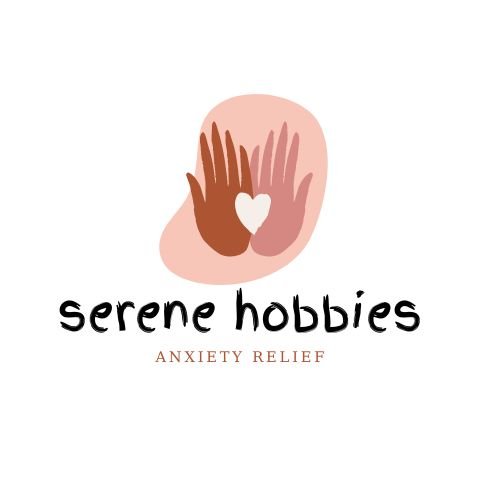




Leave a Reply